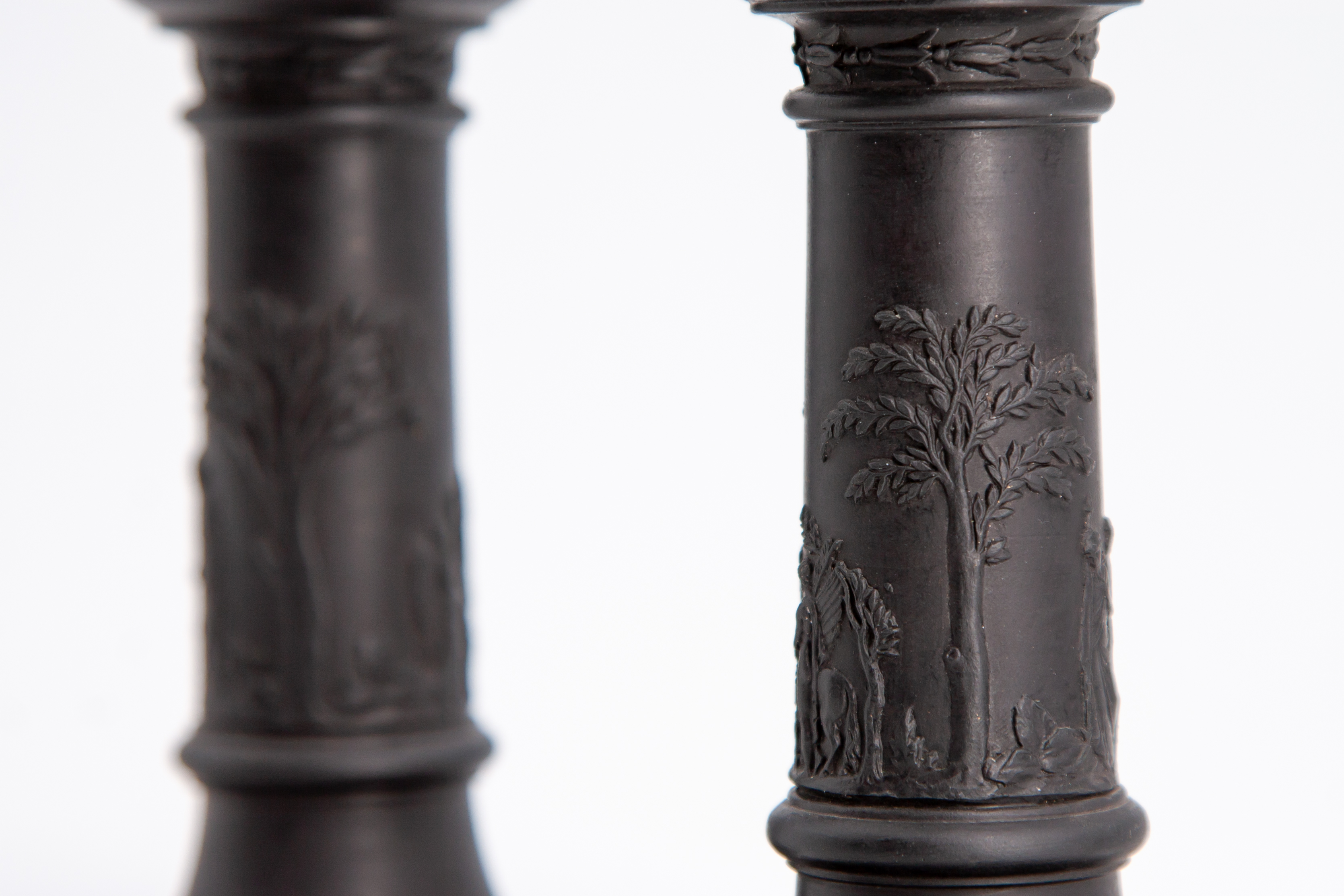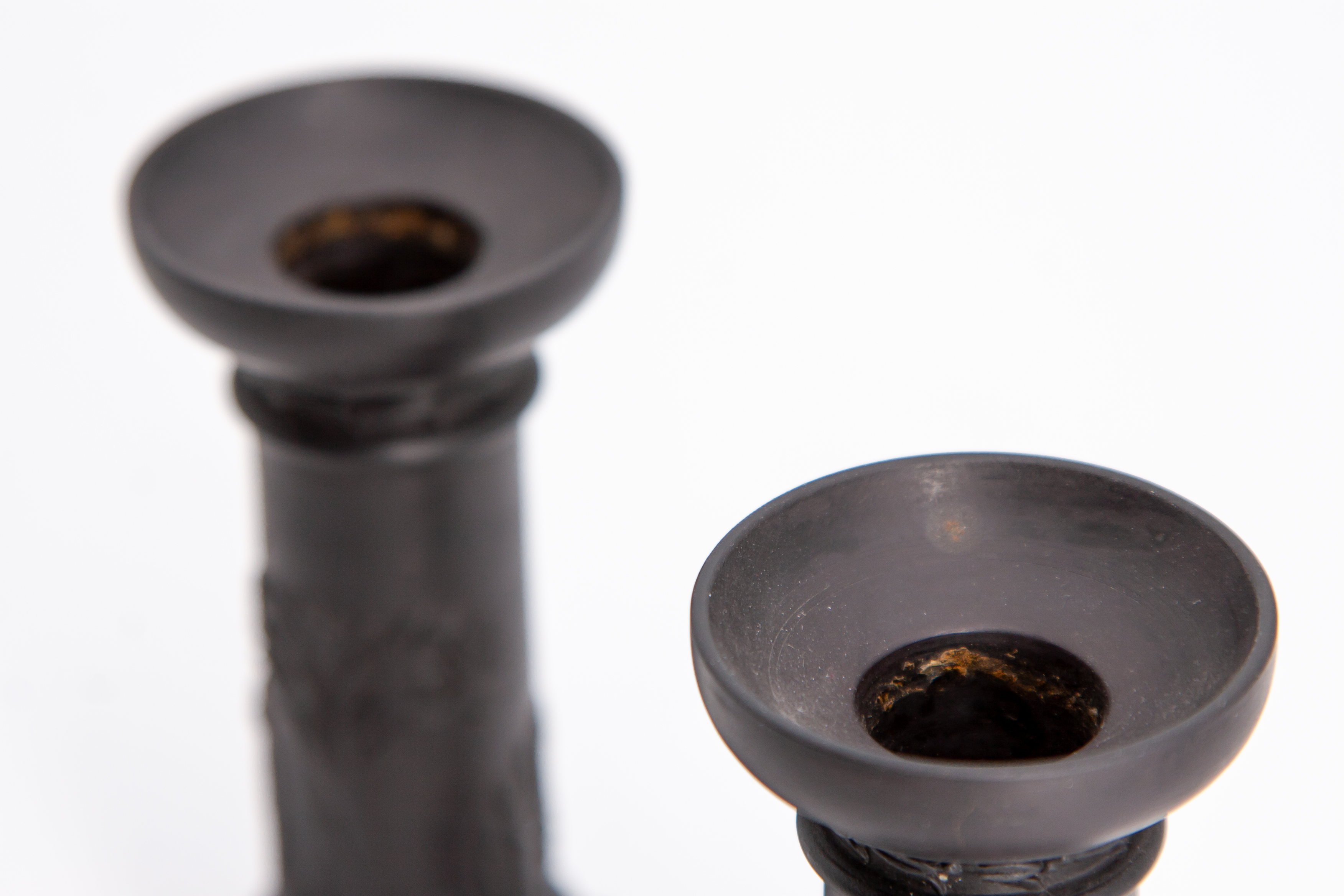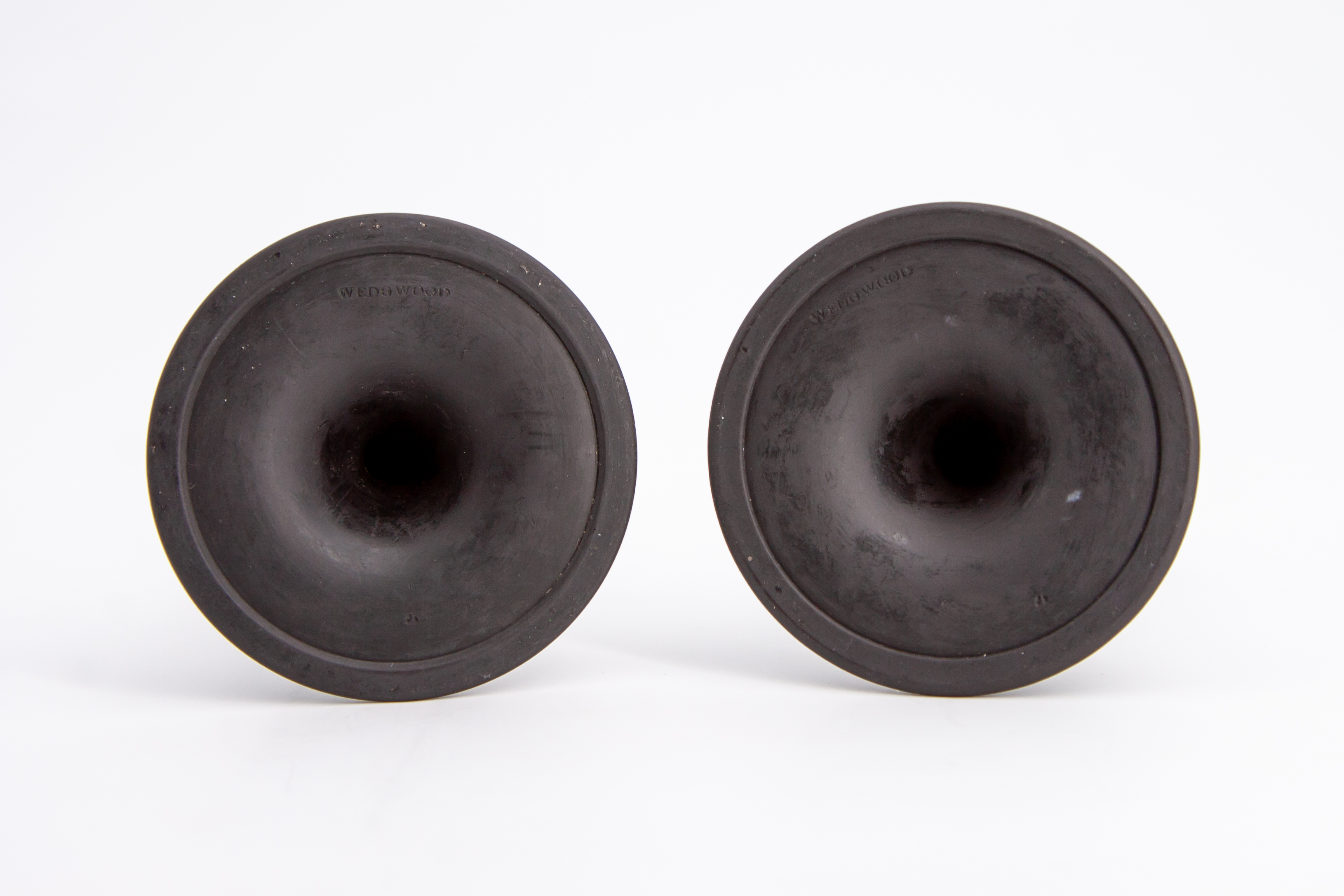Decorative objects such as these candlesticks, made by Wedgwood in the first quarter of the 19th century, reigned supreme in the black basalt medium. Black basalt wares evoked Classical Greece and Rome in their reproduction of Classic designs and in their forms inspired by Attic pottery, bronzes, and marbles. The Tuscan column forms are reminiscent of the Romantic architectural ruins of the Italian peninsula, and the allegorical scenes display a visual language of Antiquity.
Decorative objects such as these candlesticks, made by Wedgwood in the first quarter of the 19th century, reigned supreme in the black basalt medium. Black basalt wares evoked Classical Greece and Rome in their reproduction of Classic designs and in their forms inspired by Attic pottery, bronzes, and marbles. The Tuscan column forms are reminiscent of the Romantic architectural ruins of the Italian peninsula, and the allegorical scenes display a visual language of Antiquity.
Essay
Josiah Wedgwood developed his prized “black basalte” wares in 1768 as fine exemplars of the British Neoclassical style. This style, largely influenced by the British rediscovery of Antiquity through the aristocratic Grand Tour, proclaimed a heritage of Western culture, at the time perceived to be the pinnacle of civilization. The Grand Tour was primarily undertaken by young men, however these candlesticks were almost certainly designed with the female user in mind. Although women were mostly excluded from the Grand Tour, an exploration of these black basalt candlesticks reveals an entry point to female travel abroad (albeit virtually) through objects decorated in the Neoclassical style.
Beginning in the seventeenth century and lasting through the nineteenth century, the Grand Tour took the English into the Continent to experience the seat of Western culture in the Italian peninsula. Male tourists often had an education in the Classics, which made travel to ancient sites such as Rome and Naples popular. Women only occasionally embarked on the Grand Tour, and when they did so they typically focused on foreign cultural and societal customs. Any interest in Antiquity was purely decorative and aesthetic. This “patterning of Antiquity,” though in situ considered a female endeavor, became the basis for the British Neoclassical style. Indeed, an abundance of publications cataloged Ancient artifacts to serve as inspiration for modern objects. Most notable of these was Sir William Hamilton’s 1766 catalog entitled Collection of Etruscan, Greek and Roman antiquities. Other seminal catalogs of Antiquity included Bernard de Montfaucon’s L’Antiquite Expliquee et representee en figures (1722) and Count Caylus’s Receuil d’Antiquites Egyptiennes Etrusques, Greques et Romaines (1761). The major British designers owned their own copies of these texts, including Josiah Wedgwood.
These candlesticks feature many Neoclassical details which reveals the British interest in both copy of and allusion to Classical forms. The overall form of the candlesticks is that of the Tuscan column, reminiscent of the Romantic architectural ruins of the Italian peninsula. The decorative elements, made with a mold and then attached to the ceramic body, include impressed acanthus leaf decoration and swirling vines. The figural groupings on the candlesticks depict mythological subjects, likely copied directly from Sir Hamilton’s catalog. The scenes can be found on many Wedgwood black basalt wares, including these cameos in the Brooklyn Museum.
Further connecting these candlesticks to Grand Tour travels is the black basalt medium itself. The term “black basalt” references volcanic rock (Jenkins & Sloan, 1996: 182). Southern Italy was home to the famous Mount Vesuvius, which was a popular Grand Tour destination for classicists and natural historians alike. Classicists were interested in the newly unearthed artifacts at Pompeii and Herculaneum, which had a marked influence on our candlesticks as discussed above. Black basalt had also entered the public consciousness as the center of a rigorous debate on the methods of the formation of volcanic rock, the so-called neptunist-plutonist controversy. The medium would certainly have been recognized by the British people as linked to Italy.
Though black basalt wares exhibit explicit and implicit references to Antiquity, their final form is perhaps the most illuminating when it comes to understanding the gendering of each piece. As such, black basalt objects can be divided into two classes according to their intended consumer: academic and decorative. The former consists of monumental reproductions of Antique vessels, such as Wedgwood’s copy of the Portland Vase, portrait busts, and cameos, all modeled after Classical designs. These have obvious connections to the Grand Tour and to Classical Greece and Rome, and were primarily commissioned and purchased by men, who also made up the majority of Grand Tourists.
The candlesticks fall into the latter category of decorative objects intended for women and the aesthetic enhancement of the domestic space. Returning to the “patterning of Antiquity” idea, these candlesticks reproduce the designs found in Hamilton’s catalog, again a reference to women’s participation in the Grand Tour. Additionally, the candlesticks’ size points to female consumption: portable black basalt pieces were popular for their ability to enhance the whiteness of the female user’s skin (Edwards 1994). These candlesticks could be moved throughout the home to display the elite status of its owner through connection to an aristocratic tradition of traveling throughout the Continent. Though women did not typically embark on the Grand Tour, possession of Neoclassical ceramics enabled them to participate in virtual travels, thereby gaining access to the ideals which those travels embodied and the taste they sought to cultivate.
BT
Condition
Excellent.
For a detailed condition report, please contact us.
Literature
Edwards, Diana. Black Basalt: Wedgwood and Contemporary Manufacturers. Woodbridge, Suffolk: Antique Collectors’ Club, 1994.
Jenkins, Ian Jenkins and Kim Sloan. Vases and Volcanoes: Sir William Hamilton and His Collection. London: British Museum Press, 1996.
Ottomeyer, Hans. “The Metamorphosis of the Neoclassical Vase.” In Vasemania: Neoclassical Form and Ornament in Europe, edited by Heather Jane McCormick and Hans Ottomeyer, 15-30. New York: The Bard Graduate Center, 2004.
Pickering, Nicola. “‘The beautiful spirit of antiquity’: Pompeii and Herculaneum as inspiration for Neoclassical interior schemes in eighteenth-century Europe.” In Winckelman and Curiosity in the 18th-century Gentleman’s Library, edited by Katherine Harloe, Cristina Neagu, and Amy C. Smith, 70-89. Oxford: Christ Church Library, 2018.
Cited Works
Josiah Wedgwood developed his prized “black basalte” wares in 1768 as fine exemplars of the British Neoclassical style. This style, largely influenced by the British rediscovery of Antiquity through the aristocratic Grand Tour, proclaimed a heritage of Western culture, at the time perceived to be the pinnacle of civilization. The Grand Tour was primarily undertaken by young men, however these candlesticks were almost certainly designed with the female user in mind. Although women were mostly excluded from the Grand Tour, an exploration of these black basalt candlesticks reveals an entry point to female travel abroad (albeit virtually) through objects decorated in the Neoclassical style.
Beginning in the seventeenth century and lasting through the nineteenth century, the Grand Tour took the English into the Continent to experience the seat of Western culture in the Italian peninsula. Male tourists often had an education in the Classics, which made travel to ancient sites such as Rome and Naples popular. Women only occasionally embarked on the Grand Tour, and when they did so they typically focused on foreign cultural and societal customs. Any interest in Antiquity was purely decorative and aesthetic. This “patterning of Antiquity,” though in situ considered a female endeavor, became the basis for the British Neoclassical style. Indeed, an abundance of publications cataloged Ancient artifacts to serve as inspiration for modern objects. Most notable of these was Sir William Hamilton’s 1766 catalog entitled Collection of Etruscan, Greek and Roman antiquities. Other seminal catalogs of Antiquity included Bernard de Montfaucon’s L’Antiquite Expliquee et representee en figures (1722) and Count Caylus’s Receuil d’Antiquites Egyptiennes Etrusques, Greques et Romaines (1761). The major British designers owned their own copies of these texts, including Josiah Wedgwood.
These candlesticks feature many Neoclassical details which reveals the British interest in both copy of and allusion to Classical forms. The overall form of the candlesticks is that of the Tuscan column, reminiscent of the Romantic architectural ruins of the Italian peninsula. The decorative elements, made with a mold and then attached to the ceramic body, include impressed acanthus leaf decoration and swirling vines. The figural groupings on the candlesticks depict mythological subjects, likely copied directly from Sir Hamilton’s catalog. The scenes can be found on many Wedgwood black basalt wares, including these cameos in the Brooklyn Museum.
Further connecting these candlesticks to Grand Tour travels is the black basalt medium itself. The term “black basalt” references volcanic rock (Jenkins & Sloan, 1996: 182). Southern Italy was home to the famous Mount Vesuvius, which was a popular Grand Tour destination for classicists and natural historians alike. Classicists were interested in the newly unearthed artifacts at Pompeii and Herculaneum, which had a marked influence on our candlesticks as discussed above. Black basalt had also entered the public consciousness as the center of a rigorous debate on the methods of the formation of volcanic rock, the so-called neptunist-plutonist controversy. The medium would certainly have been recognized by the British people as linked to Italy.
Though black basalt wares exhibit explicit and implicit references to Antiquity, their final form is perhaps the most illuminating when it comes to understanding the gendering of each piece. As such, black basalt objects can be divided into two classes according to their intended consumer: academic and decorative. The former consists of monumental reproductions of Antique vessels, such as Wedgwood’s copy of the Portland Vase, portrait busts, and cameos, all modeled after Classical designs. These have obvious connections to the Grand Tour and to Classical Greece and Rome, and were primarily commissioned and purchased by men, who also made up the majority of Grand Tourists.
The candlesticks fall into the latter category of decorative objects intended for women and the aesthetic enhancement of the domestic space. Returning to the “patterning of Antiquity” idea, these candlesticks reproduce the designs found in Hamilton’s catalog, again a reference to women’s participation in the Grand Tour. Additionally, the candlesticks’ size points to female consumption: portable black basalt pieces were popular for their ability to enhance the whiteness of the female user’s skin (Edwards 1994). These candlesticks could be moved throughout the home to display the elite status of its owner through connection to an aristocratic tradition of traveling throughout the Continent. Though women did not typically embark on the Grand Tour, possession of Neoclassical ceramics enabled them to participate in virtual travels, thereby gaining access to the ideals which those travels embodied and the taste they sought to cultivate.
BT
Excellent.
For a detailed condition report, please contact us.
Edwards, Diana. Black Basalt: Wedgwood and Contemporary Manufacturers. Woodbridge, Suffolk: Antique Collectors’ Club, 1994.
Jenkins, Ian Jenkins and Kim Sloan. Vases and Volcanoes: Sir William Hamilton and His Collection. London: British Museum Press, 1996.
Ottomeyer, Hans. “The Metamorphosis of the Neoclassical Vase.” In Vasemania: Neoclassical Form and Ornament in Europe, edited by Heather Jane McCormick and Hans Ottomeyer, 15-30. New York: The Bard Graduate Center, 2004.
Pickering, Nicola. “‘The beautiful spirit of antiquity’: Pompeii and Herculaneum as inspiration for Neoclassical interior schemes in eighteenth-century Europe.” In Winckelman and Curiosity in the 18th-century Gentleman’s Library, edited by Katherine Harloe, Cristina Neagu, and Amy C. Smith, 70-89. Oxford: Christ Church Library, 2018.
This item ships free to the continental US, and globally for a flat-rate fee of $50.
All objects are packed with utmost care by our team of expert fine art shippers. All items are shipped with parcel insurance.
For more information on our shipping policies, please visit our FAQ Page.










